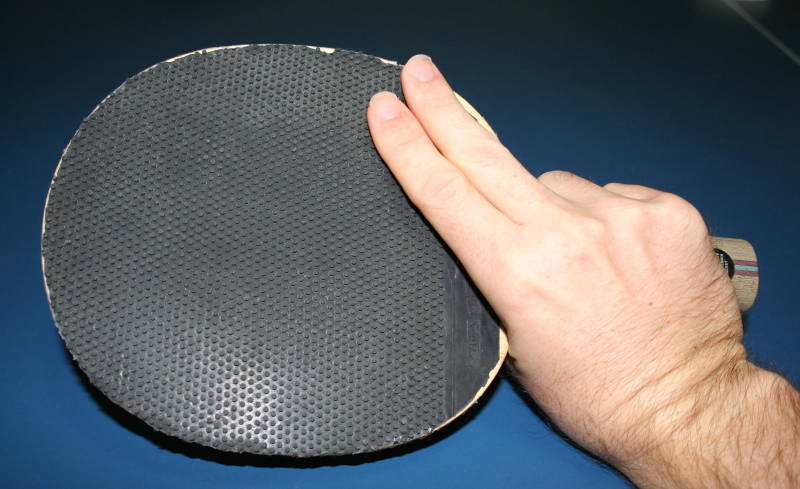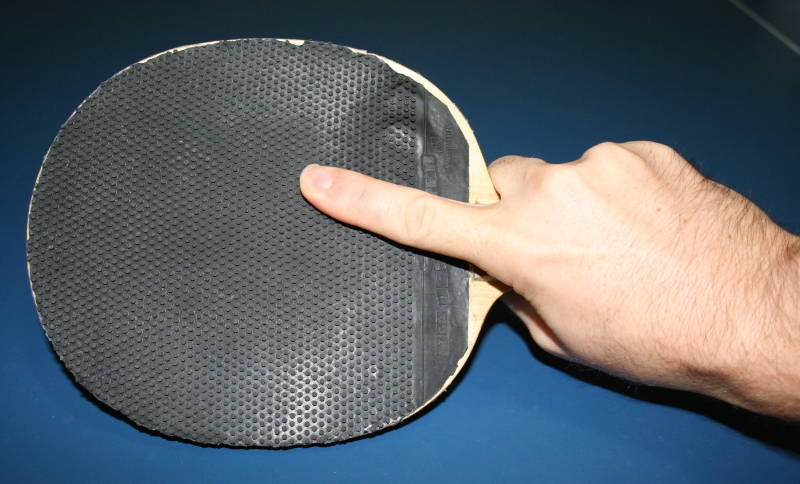They say that there is a thousand ways to skin a cat, and sometimes it seems that there are almost as many ways to hold your table tennis bat! And while variety is the spice of life, most table tennis players are better off sticking to conventional grip types.
In this image gallery I’ll be highlighting some grip variations that are not recommended for 99% of ping-pong players. You might be the exception to the majority, but for most players each of these grip variations suffer from flaws that make them less than ideal ways of holding a ping-pong paddle.
Common Grip Error – Ball of Thumb on Racket Surface

For shakehanders, the placement of the thumb running up the center of the forehand side of the racket is a common grip mistake made by ping-pong players. The picture shows one of the two common variations of this mistake, where the ball of the thumb is pressed against the rubber surface, and the racket is rotated 90 degrees in the hand, so that the thumb runs up the center of the racket.
Problems With The Grip
This grip variation suffers from a number of problems, including:
- The placement of the thumb and rotation of the racket in the hand makes hitting any type of forehand stroke very uncomfortable and awkward. The player is almost forced to play every ball with his backhand.
- Use of the wrist to add spin is very restricted at certain angles.
- Use of the wrist to add power is very difficult.
- Twiddling of the bat is very difficult due to the thumb placement.
- The ball may accidentally hit the thumb instead of the racket surface when hitting a forehand.
Common Grip Error – Side of Thumb on Racket Surface

The placement of the side of the thumb running up the center of the forehand side of the bat is the second variation of common mistakes in thumb placement.
Problems With The Grip
This grip variation is not as bad as the previous variation, since there is less locking of the wrist, and no rotation of the racket. The main problems are as follows:
- Wrist movement is still a little restricted compared to a standard shakehand grip, making it harder to snap the wrist, and achieve the required bat angle for certain strokes.
- The ball may occasionally hit the thumb by mistake, instead of the racket surface.
Common Grip Error – Two Fingers on Backhand Side

For shakehanders, the placement of two fingers on the backhand side of the bat is also a common grip error.
Problems With The Grip
This grip variation is an inferior version of the standard shakehand grip, with the following problems and no real benefits:
- The grip is less secure due to only having two fingers on the handle.
- Twiddling the bat is more difficult due to the second finger on the racket surface.
- There is an increased likelihood of the ball accidentally hitting the fingers when playing a backhand stroke.
Common Grip Error – Index Finger Placement

Holding the index finger towards the middle of the racket surface when playing a forehand is another grip variation that is used by some players.
Problems With The Grip
I would not exactly call this grip variation an error, since the forehand stroke is relatively unaffected by this grip, and most advanced players who use this grip drop their index finger back down towards the handle neck for backhand strokes. But for beginners who do not move the index finger back down for backhands, the following problems arise:
- The index finger is prone to hitting the ball accidentally.
- If the bat is otherwise held as a normal shakehander grip, there are no other major problems. But many beginners also rotate the bat in their hand 90 degrees to the left, which tends to lock out the wrist when playing backhand topspin strokes.
Conclusion
Have a look at your grip the next time you pick up your ping-pong paddle to play some table tennis. If you are making one of these four common grip errors, chances are you won’t reach your full potential due to the limitations of your grip. Now’s the time to get a grip on things and start holding your bat correctly!

